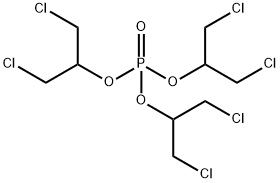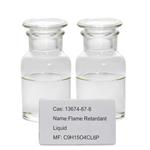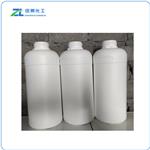Chemical Properties
Tris(1,3-dichloro-2-propyl)phosphate is a clear colorless viscous liquid with a relatively low molecular weight, low water solubility, and low lipophilicity (as indicated by log K
ow).
Uses
Tris(1,3-dichloro-2-propyl) Phosphate is a flame retardant present in polyurethane foams.
Uses
Tris(1,3-dichloro-2-propyl)phosphate [TDCPP] is a halogenated phosphorus flame retardant used in a variety of sectors, including manufacturing of paints/coatings, furniture and related products, building/construction materials, fabrics/textiles/leather products, and foam seating and bedding products (EPA, 2012).
It is used extensively as an additive to flexible polyurethane foams (PUFs). Its end uses include molded automotive seating foam (e.g., seat cushions and headrests), slabstock foam in furniture, automotive fabric lining, and car roofing (ECHA, 2013). It is a high production volume chemical.
Definition
ChEBI: Tris(1,3-dichloropropan-2-yl) phosphate is a trialkyl phosphate.
General Description
Clear colorless viscous liquid. Generally a super-cooled liquid at room temperature but may occasionally solidify when held at low temperatures for prolonged periods.
Air & Water Reactions
Insoluble in water.
Reactivity Profile
Fyrol FR 2 hydrolyzes slowly when refluxed with an aqueous acid. Under alkaline conditions, Fyrol FR 2 exhibits a slow cleavage. Fyrol FR 2 has plasticizing properties and, as such, may soften or deteriorate certain plastics and elastomers (particularly vinyl-based resin, neoprene and natural rubbers).
Fire Hazard
Fyrol FR 2 is combustible.
Safety Profile
Moderately toxic by
ingestion. An experimental teratogen. Experimental reproductive effects.
Questionable carcinogen with experimental
carcinogenic data. Mutation data reported.
When heated to decomposition it emits
toxic fumes of Cland POx.
Environmental Fate
A series of studies have been performed to evaluate the environmental fate and bioaccumulation potential of Tris(1,3-dichloro-2-propyl)phosphate (TDCPP).EU concluded that TDCPP is expected to be persistent in water, sediment, sewage sludge, and soil. When emitted to the environment, the EU concluded that TDCPP will likely adsorb to particulate matter, based on its low volatility and relatively high adsorption coefficient. The Henry’s law constant suggests that TDCPP will preferentially partition to water, rather than air. When assessing TDCPP's potential for persistence or bioaccumulation, the EU determined that TDCPP can potentially be persistent or very persistent and that it does not meet the criteria for bioaccumulative or very bioaccumulative compounds.





